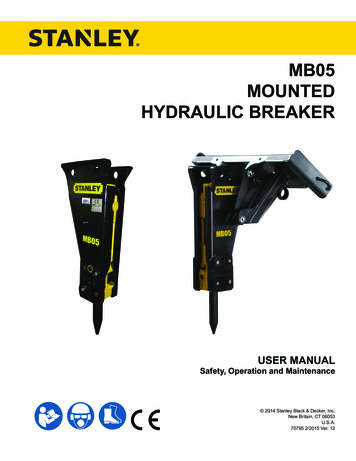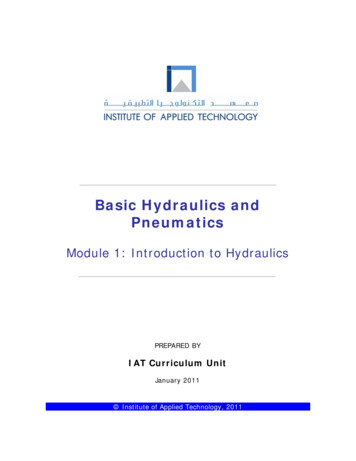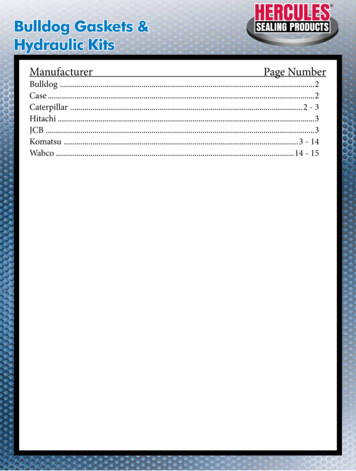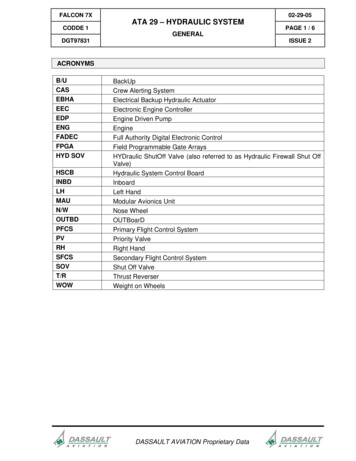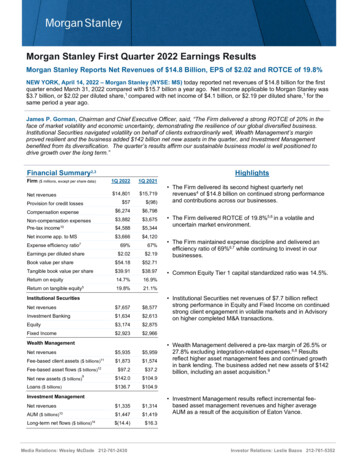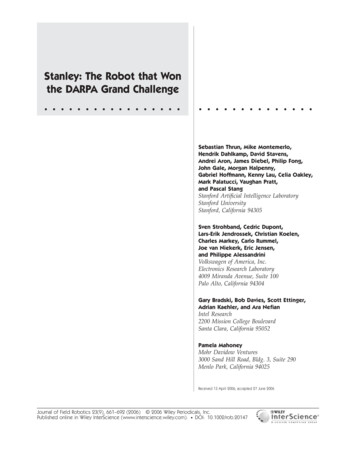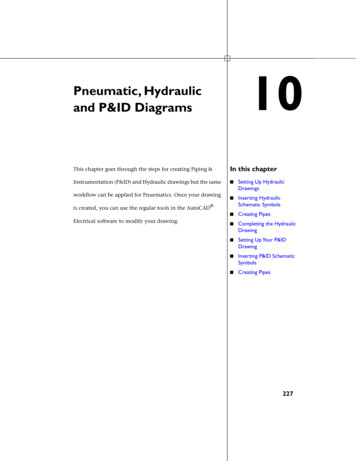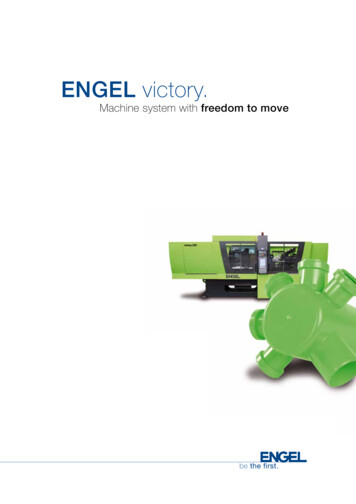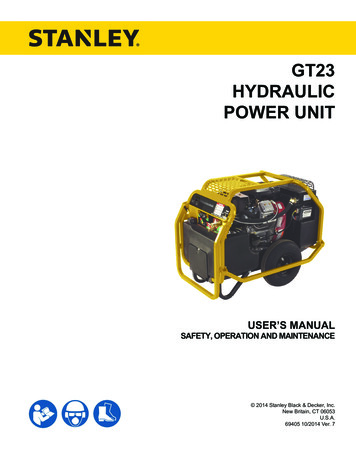
Transcription
GT23HYDRAULICPOWER UNITUSER’S MANUALSAFETY, OPERATION AND MAINTENANCE 2014 Stanley Black & Decker, Inc.New Britain, CT 06053U.S.A.69405 10/2014 Ver. 7
NOTES2 GT23 User Manual
TABLE OF CONTENTSSAFETY SYMBOLS. 4SAFETY PRECAUTIONS. 5TOOL STICKERS & TAGS. 6HYDRAULIC HOSE REQUIREMENTS. 7HOSE SAFETY TAGS. 7HOSE RECOMMENDATIONS. 8HTMA REQUIREMENTS. 9OPERATION. 10PREPARATION FOR USE. 10CONTROLS. 12STARTUP. 12FOR 8 GPM OPERATION. 12FOR 12 GPM OPERATION. 12COLD WEATHER STARTUP. 13SHUTDOWN. 13ROUTINE MAINTENANCE. 14STORAGE. 14PROGRAMMABLE CONTROLLER. 15TROUBLESHOOTING GUIDELINES. 15FAULT CODES. 16TESTING & TROUBLESHOOTING. 17TESTING THE HYDRAULIC CIRCUIT. 17TESTING THE 8 GPM HTMA TYPE II CIRCUIT. 17OR THE 12 GPM TYPE III CIRCUIT. 17TROUBLESHOOTING. 18SPECIFICATIONS. 19BRIGGS ENGINE ASSEMBLY. 20BRIGGS ENGINE PARTS LIST. 21FUEL TANK & CAP. 22FRAME PARTS. 23HOSES, FITTINGS & CLAMPS. 24MAIN POWER UNIT WIRING HARNESS. 25IMPORTANTTo fill out a Product Warranty Validation form, and for information on your warranty,visit Stanleyhydraulics.com and select the Company tab, Warranty.(NOTE: The warranty Validation record must be submitted to validate the warranty).SERVICING: This manual contains safety, operation, and routine maintenance instructions. Stanleyrecommends that servicing of hydraulic tools, other than routine maintenance, must be performed by anauthorized and certified dealer. Please read the following warning.WARNINGSERIOUS INJURY OR DEATH COULD RESULT FROM THE IMPROPER REPAIR OR SERVICE OF THIS TOOL.REPAIRS AND / OR SERVICE TO THIS TOOL MUST ONLY BEDONE BY AN AUTHORIZED AND CERTIFIED DEALER.For the nearest authorized and certified dealer, call Stanley Hydraulic Tools at the number listed on theback of this manual and ask for a Customer Service Representative.GT23 User Manual 3
SAFETY SYMBOLSSafety symbols and signal words, as shown below, are used to emphasize all operator, maintenance and repair actions which, if not strictly followed, could result in a life-threatening situation, bodily injury or damage to equipment.This is the safety alert symbol. It is used to alert you to potential personal injuryhazards. Obey all safety messages that follow this symbol to avoid possibleinjury or death.DANGERThis safety alert and signal word indicate an imminently hazardous situationwhich, if not avoided, will result in death or serious injury.WARNINGThis safety alert and signal word indicate a potentially hazardous situationwhich, if not avoided, could result in death or serious injury.CAUTIONThis safety alert and signal word indicate a potentially hazardous situationwhich, if not avoided, could result in death or serious injury.CAUTIONThis signal word indicates a potentially hazardous situation which, if not avoided, may result in property damage.NOTICEThis signal word indicates a situation which, if not avoided, will result in damageto the equipment.IMPORTANTThis signal word indicates a situation which, if not avoided, may result in damage to the equipment.Always observe safety symbols. They are included for your safety and for the protection of the tool.LOCAL SAFETY REGULATIONSEnter any local safety regulations here. Keep these instructions in an area accessible to the operator and maintenance personnel.4 GT23 User Manual
SAFETY PRECAUTIONSTool operators and maintenance personnel must always comply with the safety precautions given in this manual and on thestickers and tags attached to the equipment.These safety precautions are given for your safety. Review them carefully before operating the tool and before performinggeneral maintenance or repairs.Supervising personnel should develop additional precautions relating to the specific work area and local safety regulations. Ifso, place the added precautions in the space provided on page 4.In addition to this manual, read and understand safety and operating instructions in the Engine Operation Manual furnishedwith the power unit.The Hydraulic Power Unit will provide safe and dependable service if operated in accordance with the instructions given in thismanual. Read and understand this manual and any stickers and tags attached to the Power Unit. Failure to do so could resultin personal injury or equipment damage. Operator must start in a work area without bystanders. The operator must be familiar with all prohibited work areas such asexcessive slopes and dangerous terrain conditions. Establish a training program for all operators to ensure safe operation. Do not operate the power unit unless thoroughly trained or under the supervision of an instructor. Always wear safety equipment such as goggles, ear, head protection, and safety shoes at all times when operating thepower unit and a hydraulic tool. Do not inspect or clean the power unit while it is running. Accidental engagement of the unit can cause serious injury. Always use hoses and fittings rated at 2500 psi/172 bar with a 4 to 1 safety factor. Be sure all hose connections are tight. Be sure all hoses are connected for correct flow direction to and from the tool being used. Do not inspect hoses and fittings for leaks by using bare hands. “Pin-hole” leaks can penetrate the skin. NEVER OPERATE THE POWER UNIT IN A CLOSED SPACE. Inhalation of engine exhaust can be fatal. Do not operate a damaged, improperly adjusted power unit. Never wear loose clothing that can get entangled in the working parts of the power unit. Keep all parts of your body away from the working parts of the power unit. Keep clear of hot engine exhaust. Do not add fuel to the power unit while the power unit is running or is still hot. Do not operate the power unit if gasoline odor is present. Do not use flammable solvents around the power unit engine. Do not operate the power unit within 3.3 ft/1 m of buildings, obstructions or flammable objects. Do not reverse tool rotation direction by changing fluid flow direction. Allow power unit engine to cool before storing in an enclosed space. Always keep critical tool markings, such as labels and warning stickers legible. To avoid personal injury or equipment damage, all tool repair, maintenance and service must only be performed by authorized and properly trained personnel.GT23 User Manual 5
DASH DECALSStanley Dash Sticker 62302Single Circuit Sticker 685956 GT23 User Manual
HYDRAULIC HOSE REQUIREMENTSHOSE TYPESThe rated working pressure of the hydraulic hose must be equal to or higher than the relief valve setting on thehydraulic system.There are three types of hydraulic hose that meet this requirement and are authorized for usewith Stanley Hydraulic Tools. They are:Certified non-conductive - constructed of thermoplastic or synthetic rubber inner tube, synthetic fiberbraid reinforcement, and weather resistant thermoplastic or synthetic rubber cover. Hose labeled certified nonconductive is the only hose authorized for use near electrical conductors.Wire-braided (conductive) - constructed of synthetic rubber inner tube, single or double wire braid reinforcement, and weather resistant synthetic rubber cover. This hose is conductive and must never be used nearelectrical conductors.Fabric-braided (not certified or labeled non-conductive) - constucted of thermoplastic or synthetic rubberinner tube, synthetic fiber braid reinforcement, and weather resistant thermoplastic or synthetic rubber cover. Thishose is not certified non-conductive and must never be used near electrical conductors.HOSE SAFETY TAGSTo help ensure your safety, the following DANGER tags are attached to all hose purchased from Stanley Hydraulic Tools. DO NOT REMOVE THESE TAGS.If the information on a tag is illegible because of wear or damage, replace the tag immediately. A new tag may beobtained from your Stanley Distributor.D A N G E RD A N G E R1 FAILURE TO USE HYDRAULIC HOSE LABELED AND CERTIFIED AS NON-CONDUCTIVEWHEN USING HYDRAULIC TOOLS ON OR NEAR ELECTRIC LINES MAYRESULT IN DEATHOR SERIOUS INJURY.FOR PROPER AND SAFE OPERATION MAKE SURE THAT YOU HAVE BEEN PROPERLYTRAINED IN CORRECT PROCEDURES REQUIRED FOR WORK ON OR AROUNDELECTRIC LINES.2. BEFORE USING HYDRAULIC HOSE LABELED AND CERTIFIED AS NON-CONDUCTIVE ONOR NEAR ELECTRIC LINES. WIPE THE ENTIRE LENGTH OF THE HOSE AND FITTINGWITH A CLEAN DRY ABSORBENT CLOTH TO REMOVE DIRT AND MOSISTURE AND TESTHOSE FOR MAXIMUM ALLOWABLE CURRENT LEAKAGE IN ACCORDANCE WITH SAFETYDEPARTMENT INSTRUCTIONS.3. DO NOT EXCEED HOSE WORKING PRESSURE OR ABUSE HOSE. IMPROPER USE ORHANDLING OF HOSE COULD RESULT IN BURST OR OTHER HOSE FAILURE. KEEPHOSE AS FAR AWAY AS POSSIBLE FROM BODY AND DO NOT PERMIT DIRECT CONTACTDURING USE. CONTACT AT THE BURST CAN CAUSE BODILY INJECTION AND SEVEREPERSONAL INJURY.4. HANDLE AND ROUTE HOSE CAREFULLY TO AVOID KINKING, ABRASION, CUTTING, ORCONTACT WITH HIGH TEMPERATURE SURFACES. DO NOT USE IF KINKED. DO NOT USEHOSE TO PULL OR LIFT TOOLS, POWER UNITS, ETC.5. CHECK ENTIRE HOSE FOR CUTS CRACKS LEAKS ABRASIONS, BULGES, OR DAMAGE TOCOUPLINGS IF ANY OF THESE CONDITIONS EXIST, REPLACE THE HOSE IMMEDIATELY.NEVER USE TAPE OR ANY DEVICE TO ATTEMPT TO MEND THE HOSE.6. AFTER EACH USE STORE IN A CLEAN DRY AREA.SEE OTHER SIDE3DO NOT REMOVE THIS TAGDO NOT REMOVE THIS TAGTHE TAG SHOWN BELOW IS ATTACHED TO “CERTIFIED NON-CONDUCTIVE” HOSESEE OTHER SIDESIDE 1(shown smaller than actual size)SIDE 2D A N G E R1 DO NOT USE THIS HYDRAULIC HOSE ON OR NEAR ELECTRIC LINES. THIS HOSE ISNOT LABELED OR CERTIFIED AS NON-CONDUCTIVE. USING THIS HOSE ON OR NEARELECTRICAL LINES MAY RESULT IN DEATH OR SERIOUS INJURY.2. FOR PROPER AND SAFE OPERATION MAKE SURE THAT YOU HAVE BEEN PROPERLYTRAINED IN CORRECT PROCEDURES REQUIRED FOR WORK ON OR AROUNDELECTRIC LINES.D A N G E R5. CHECK ENTIRE HOSE FOR CUTS CRACKS LEAKS ABRASIONS, BULGES, OR DAMAGE TOCOUPLINGS IF ANY OF THESE CONDITIONS EXIST, REPLACE THE HOSE IMMEDIATELY.NEVER USE TAPE OR ANY DEVICE TO ATTEMPT TO MEND THE HOSE.6. AFTER EACH USE STORE IN A CLEAN DRY AREA.3. DO NOT EXCEED HOSE WORKING PRESSURE OR ABUSE HOSE. IMPROPER USE ORHANDLING OF HOSE COULD RESULT IN BURST OR OTHER HOSE FAILURE. KEEPHOSE AS FAR AWAY AS POSSIBLE FROM BODY AND DO NOT PERMIT DIRECT CONTACTDURING USE. CONTACT AT THE BURST CAN CAUSE BODILY INJECTION AND SEVEREPERSONAL INJURY.4. HANDLE AND ROUTE HOSE CAREFULLY TO AVOID KINKING, CUTTING, OR CONTACTWITH HIGH TEMPERATURE SURFACES. DO NOT USE IF KINKED. DO NOT USE HOSE TOPULL OR LIFT TOOLS, POWER UNITS, ETC.DO NOT REMOVE THIS TAGDO NOT REMOVE THIS TAGTHE TAG SHOWN BELOW IS ATTACHED TO “CONDUCTIVE” HOSE.SEE OTHER SIDESIDE 1(shown smaller than actual size)SIDE 2GT23 User Manual 7
8 GT23 User ManualAll hydraulic hose must meet or exceed specifications as set forth by SAE J517.All hydraulic hose must have at least a ratedminimum working pressure equal to the maximumhydraulic system relief valve setting.This chart is intended to be used for hydraulic toolapplications only based on Stanley Hydraulic Toolstool operating requirements and should not be usedfor any other applications.The chart to the right shows recommended minimum hose diameters for various hose lengthsbased on gallons per minute (gpm)/liters per minute (lpm). These recommendations are intendedto keep return line pressure (back pressure) to aminimum acceptable level to ensure maximum toolperformance.Tool to Hydraulic Circuit Hose Recommendations38-4938-4910-1310-13up to 10up to 3FLOW RETURN FLOWPRESSURE26-100up to 25100-20051-100up to 50100-30051-100up to 5026-100up to 258-30up to 830-6015-30up to 1530-9015-30up to 157.5-30up to 7.5Typical Hose -4919-405-10.510-1315-2315-234-613-16MMInside 175175175175175155BARMin. Working PressureCertified Non-Conductive Hose - Fiber Braid - for Utility Bucket TrucksMETERSHose LengthsFEETConductive Hose - Wire Braid or Fiber Braid -DO NOT USE NEAR ELECTRICAL CONDUCTORS15-344-64-9LPMOil FlowGPMHOSE RECOMMENDATIONS
HTMA / EHTMA REQUIREMENTSHTMA / EHTMA REQUIREMENTSHTMAHYDRAULIC SYSTEM REQUIREMENTSTYPE INominal Operating Pressure(at the power supply outlet)4-6 gpm(15-23 lpm)1500 psi(103 bar)TOOL TYPETYPE IITYPE RR7-9 gpm(26-34 lpm)1500 psi(103 bar)9-10.5 gpm(34-40 lpm)1500 psi(103 bar)System relief valve setting(at the power supply outlet)2100-2250 psi(145-155 bar)2100-2250 psi(145-155 bar)2200-2300 psi(152-159 bar)2100-2250 psi(145-155 bar)Maximum back pressure(at tool end of the return hose)250 psi(17 bar)250 psi(17 bar)250 psi(17 bar)250 psi(17 bar)Measured at a max. fluid viscosity of:(at min. operating temperature)400 ssu*400 ssu*400 ssu*400 ssu*(82 centistokes) (82 centistokes) (82 centistokes) (82 centistokes)Temperature: Sufficient heat rejectioncapacity to limit max. fluid temperature to:(at max. expected ambient temperature)140 F(60 C)Flow Range140 F(60 C)140 F(60 C)TYPE III11-13 gpm(42-49 lpm)1500 psi(103 bar)140 F(60 C)3 hp5 hp6 hp7 hpMin. cooling capacity at a temperature(2.24 kW)(3.73 kW)(5.22 kW)(4.47 kW)difference of between ambient and fluid40 F40 F40 F40 Ftemps(22 C)(22 C)(22 C)(22 C)NOTE:Do not operate the tool at oil temperatures above 140 F (60 C). Operation at higher temperatures can cause operatordiscomfort at the tool.FilterMin. full-flow filtrationSized for flow of at least:(For cold temp. startup and max.dirt-holding capacity)25 microns30 gpm(114 lpm)Hydraulic fluid Petroleum based(premium grade, anti-wear, non-conductive)Viscosity (at min. and max. operating temps)100-400 ssu*25 microns30 gpm(114 lpm)25 microns30 gpm(114 lpm)100-400 ssu*100-400 ssu*(20-82 centistokes)25 microns30 gpm(114 lpm)100-400 ssu*NOTE:When choosing hydraulic fluid, the expected oil temperature extremes that will be experienced in service determine themost suitable temperature viscosity characteristics. Hydraulic fluids with a viscosity index over 140 will meet the requirementsover a wide range of operating temperatures.*SSU Saybolt Seconds UniversalEHTMAHYDRAULIC SYSTEMREQUIREMENTSCLASSIFICATIONBCDNominal Operating Pressure(at the power supply outlet)3.5-4.3 gpm(13.5-16.5 lpm)1870 psi(129 bar)4.7-5.8 gpm(18-22 lpm)1500 psi(103 bar)7.1-8.7 gpm(27-33 lpm)1500 psi(103 bar)9.5-11.6 gpm(36-44 lpm)1500 psi(103 bar)11.8-14.5 gpm(45-55 lpm)1500 psi(103 bar)System relief valve setting(at the power supply outlet)2495 psi(172 bar)2000 psi(138 bar)2000 psi(138 bar)2000 psi(138 bar)2000 psi(138 bar)Flow RangeNOTE: These are general hydraulic system requirements. See tool specification page for tool specific requirementsGT23 User Manual 9
OPERATIONPREPARATION FOR USEDo not operate the power unit until you have read theengine operating and maintenance instructions manualfurnished with the unit.1. ENGINE CRANKCASE OIL LEVELAlways check the oil level before starting the engine. Makesure the oil level is at the FULL MARK on the dipstick. Donot overfill. Use detergent oil classified "For Service SE, SF,SG" as specified in the engine operating and maintenancemanual. See engine manual for oil viscosity grade.5. HYDRAULIC CONNECTIONSThe recommended hose length is 25 ft/8 m with a 1/2inch/12.7 mm inside diameter. The hoses must have aworking pressure rating of at least 2500 psi/175 bar. Eachhose end must have male thread ends compatible withH.T.M.A. (HYDRAULIC TOOL MANUFACTURERS ASSOCIATION) quick disconnect fittings (NPT type threads).(See Page 8.)2. SPARK PLUGOn power units equipped with Briggs & Stratton Engines,ONLY Champion RC12YC or equivalent can be used.Incorrect type spark plugs can produce radio frequencyinterference that will corrupt and damage the controller.Failure to use the correct spark plug could result in a warranty that will not be considered.Figure 1. Panel Control ValveFacing the panel control valve, the bottom male quickdisconnect fitting is the PRESSURE FLUID OUT fitting. Thetop female quick disconnect fitting is the RETURN FLUIDIN fitting.3. ENGINE FUEL LEVELCheck the fuel level. If low, fill with un-leaded gasoline witha minimum of 85 octane.4. HYDRAULIC FLUIDRECOMMENDED HYDRAULIC OILSBelow is a list of recommended oils by e AW32AMS OilNoHVH 32Exxon MobilNoUnivis HVI26*Exxon MobilNoDTE 10 ExcelShellNoS2 V 32ChevronNoRando HDZ 32Conoco PhillipsNoUnax AW-WR-32Clarion (CITGO)YesGreen Bio 32Exxon MobilYesEAL 224HChevronYesClarity AW32TerresolveYesEnvirologic 132ShellYesNaturelle HF-E-32* Recommended for extreme cold temperatures10 GT23 User ManualQUICK DISCONNECT COUPLERSH.T.M.A. approved quick disconnect couplings are installedto hydraulic hoses so that the direction of oil flow is alwaysfrom the male to the female quick disconnect as shownon page 8. Quick disconnect couplings and hose fittingsare selected so that additional fittings such as reducer oradapter fittings are not required.If adapter fittings are used, they must be approved steelhydraulic fittings meeting a minimum operating pressurerating of 2500 psi/172 bar. Do not use galvanized pipe fittings or black pipe fittings.Use thread tape or pipe joint compound when installingquick disconnect couplings to hose or tool fittings. Followthe instructions furnished with the selected thread sealant.DO NOT OVERTIGHTEN THE FITTINGS.
OPERATION6. BATTERYThe supplied 12 Volt DC battery is a non-spillable, maintenance-free battery and is fully charged.Make sure the battery cables are tight and charging circuitfunctions are operating properly.Do not charge the battery with a standard automotive battery charger. This type of charger produces a charging amperage higher than 2 amps.Charging the battery at higher than 2 amps willdamage the battery.If the engine runs out of gas or dies during operation and the ignition switch is left in the ON orRUN position, this could drain the battery. Makesure the ignition switch is returned to the OFFposition.GT23 User Manual 11
OPERATIONCONTROLSThis unit is equipped with an advanced proportional enginecontrol system. It provides a means of controlling enginespeed by adjusting the fuel control lever with an actuator.The Power Unit provides one circuit, with an oil flow of 8gpm/30 lpm up to 2000 psi/140 bar or 12 gpm/45 lpm upto 2000 psi/140 bar with a factory-programmed electronicgoverned engine throttle.THROTTLE CONTROLSWITCHthrottle controlswitchflow selectorswitchIGNITION SWITCH FLOW SELECTOR SWITCHNote:It may be necessary to reset the Controller.At times it may be neccessary to reset the controller. Thiscould happen if a fault occurs in the controller. For example, excessive engine speed. If a fault does occur thepower unit will return to an idle and the operator will haveno control of the unit. To reset the controller, simply turn offthe power unit and restart it.STARTUPBefore starting the engine make sure the flow selectorswitch is in the OFF position.Note:The power unit will not start if the flow control switch isnot in the "OFF" position.ignition switchFigure 3. Panel Control ValveOne hydraulic tool can be connected to the tool circuit.The circuit is activated by turning the flow control switch toeither the 8 gpm/30 lpm or 12 gpm/45 lpm setting.THROTTLE CONTROLThe throttle control permits the operator to select one of 2operating modes after the engine has warmed up. Whenstarting the engine, make sure the flow selector switch is inthe OFF position. The throttle control switch can be set ineither the AUTO-IDLE-ON or AUTO-IDLE-OFF positions.AUTO-ONWhen the throttle control switch is in the "AUTO-ON" position, the oil flow is regulated automatically when the triggeron the tool activated. When the tool is not being used theengine will return to idle automatically, after a 10 seconddelay.This setting will produce 8 gpm/30 lpm or 12 gpm/45 lpmdepending on which postion the operator has selected withthe flow selector switch.AUTO-OFFWhen the throttle control switch is in the "AUTO-OFF" position, the engine speed is held to maintain 8 gpm/30 lpm or12 gpm/45 lpm depending on which position the operatorhas selected with the flow selector switch. When a tool isnot being used the engine will not return to idle until eitherthe flow selector switch is turned to the OFF position or thethrottle control switch is turned to AUTO-ON.Pull choke knob out and move the Throttle Control Switchto the auto-idle-off or the auto-idle-on position, whichevermode of operation the operator prefers. Ensure the flowselector switch is in the OFF position.Turn the Ignition Switch to the START position. After theengine starts, release the switch.Gradually push in the choke knob as the engine begins toidle smoothly.Allow the engine to warm up.Connect hoses and the tool as desrcribed on page 8 and10.FOR 8 GPM OPERATIONFor 8 gpm operation, select mode of operation with theThrottle Control switch, either auto-idle-on or the auto-idleoff position. Move the flow selector switch to the 8 gpmposition.When finished operating the tool, move the flow selectorswitch to the OFF position.FOR 12 GPM OPERATIONFor 12 gpm operation, select mode of operation with theThrottle Control Switch, either auto-idle-on or the auto-idleoff position. Move the flow selector switch to the 12 gpmposition.When finished operating the tool, move the flow selectorswitch to the OFF position.12 GT23 User Manual
OPERATIONCOLD WEATHER STARTUP1. Use the procedures described under "STARTUP" andthen follow the procedure below.2. Hydraulic fluids are thicker in cold weather. Therefore,it is recommended that the engine be run at low idle longenough to bring the fluid temperature up to a minimum of50 F/10 C.3. If the tools and tool hoses are cold, it is recommendedto allow hydraulic fluid to circulate through the tool hosesuntil warm before using the tool.SHUTDOWN1. Ensure the flow selector switch in the OFF position(center position).2. Unless already at idle the power unit should return toidle. This may take a few seconds for the unit to react dueto a built-in program delay.3. Allow the engine to idle for approximately one minuteand move the Ignition Switch to the OFF position.GT23 User Manual 13
ROUTINE MAINTENANCEENGINE MAINTENANCESTORAGEFollow the maintenance schedule and general maintenanceinstructions in the engine maintenance and operationmanual furnished with the power unit. Clean the unit thoroughly before storage. Do not usewater pressure.HYDRAULIC SYSTEM MAINTENANCE Always store the unit in a clean and dry facility. Check hydraulic fluid level daily. Add fluid per specifications in this manual. (See "HYDRAULIC FLUID" under thesection titled "OPERATION". If the unit will be stored for a prolonged period (over 30days), add a fuel additive to the fuel tank to prevent the fuelfrom gumming. Run engine for a short period to circulatethe additive. Remove condensed moisture from the hydraulicfluid by pumping the hydraulic fluid into a 5 gal/20 l container through the pressure hose. Make sure the engine isat idle when performing this procedure. When the hydraulicreservoir is empty turn the engine off immediately. Allow the fluid to sit long enough for the water to settle tothe bottom of the container. Slowly pour the fluid back intothe hydraulic tank, avoiding the water at the bottom of thecontainer. Each day, check hydraulic lines and fittings for leaks,kinks, etc. Do not use your hand to perform this check. Change the hydraulic filter element every 200 hours ofoperation. Change more often if cold, moist or dusty conditions exist. Check oil cooler for debris. Remove debris with air pressure.SPARK PLUGSOn power units equipped with Briggs & Stratton Engines,ONLY Champion RC12YC or equivalent can be used.Incorrect type spark plugs can produce radio frequencyinterference that will corrupt and damage the controller.Failure to use the correct spark plug could result in a warranty that will not be considered.14 GT23 User Manual Replace crankcase oil with new oil. Remove spark plugs and pour approximately 1 ounce (30ml) of engine oil into each cylinder. Replace spark plugsand crank the engine slowly to distribute the oil. Check hydraulic reservoir for water. If water is found,change the oil and circulate it through the tool hose andtool. Disconnect tool hoses.
PROGRAMMABLE CONTROLLERThe Stanley programmable controller is an electronicengine governor that provides a means of controlling andlimiting engine speed by adjusting the fuel control lever witha proportional actuator.The controller is factory programmable and has no manualadjustments.A flashing LED indicatesthe fault condition1. Disconnect red wires from the control module to actuator.2. Attach jumper wires from battery to the RED wires toactuator.3. Actuator should move throttle lever to wide open position.a. If actuator does not move it is defective. (Replace).b. If actuator moves throttle to wide
with Stanley Hydraulic Tools. They are: Certified non-conductive - constructed of thermoplastic or synthetic rubber inner tube, synthetic fiber braid reinforcement, and weather resistant thermoplastic or synthetic rubber cover. Hose labeled certified non-conductive is the only hose authorized for use near electrical conductors.
